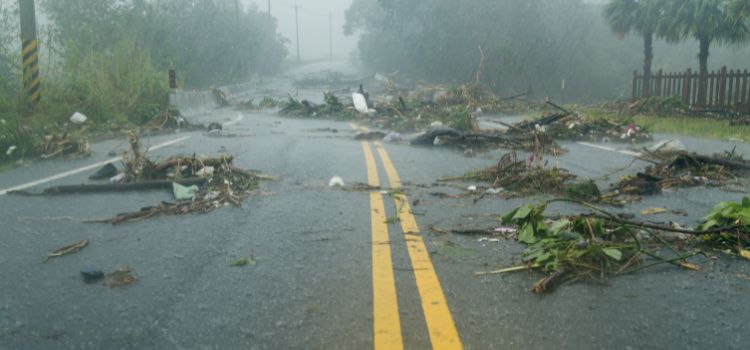When it comes to natural disasters, hurricanes are some of the most destructive forces of nature that can wreak havoc on coastal communities. But how far inland can a hurricane go? This is a question that has been asked by many people living near the coastlines of the United States, and the answer is not always straightforward.
Contents
As we know, hurricanes are massive storms that form over warm ocean waters and can cause catastrophic damage when they make landfall. The storm surge, high winds, and heavy rain associated with hurricanes can cause flooding, power outages, and destruction of homes and infrastructure. While hurricanes are typically associated with coastal regions, they can also travel inland and cause significant damage in areas far away from the coast.
So, how far inland can a hurricane go? The answer depends on many factors, including the size and strength of the storm, the topography of the land, and the angle at which the storm makes landfall. In general, hurricanes can travel hundreds of miles inland and can cause damage in areas far from the coast. In some cases, hurricanes have even caused significant damage in states as far inland as Ohio and Pennsylvania.
Hurricanes and Their Reach
Understanding Hurricanes
We have all seen the destruction that hurricanes can cause. These powerful storms can bring devastating winds, storm surges, and flooding. Hurricanes are tropical cyclones that form over warm ocean waters. They are categorized by their wind speed, with Category 5 hurricanes having the strongest winds.
How Hurricanes Form
Hurricanes form when warm, moist air masses over the ocean rises and cools, causing water vapor to condense into clouds. As the clouds continue to grow, they begin to rotate due to the Coriolis effect. This rotation creates a low-pressure system, which draws in more warm, moist air from the surrounding area. As the storm grows stronger, it can develop an eye in the center, which is a calm area with clear skies.
The Reach of Hurricanes
Hurricanes can have a significant reach, with wind and rain impacting areas far inland from the coast. The extent of the impact depends on the size and strength of the storm, as well as the topography of the area. For example, hurricanes that make landfall in areas with mountains or hills can cause more significant flooding due to the runoff from the hills. It is essential to prepare for hurricanes, even if you live inland. Strong winds can knock down trees and power lines, causing widespread power outages. Heavy rain can cause flash flooding, which can be dangerous and deadly. Make sure you have an emergency kit and a plan in place in case of a hurricane.
Factors that Affect Inland Reach of Hurricanes
When it comes to the inland reach of hurricanes, there are several factors that can affect how far they travel. Understanding these factors can help us better predict the potential impact of a hurricane and prepare accordingly. In this section, we will discuss the three main factors that affect the inland reach of hurricanes.
Wind Speed and Direction
The wind speed and direction of a hurricane can greatly impact how far inland it will reach. The stronger the winds, the more likely the hurricane is to travel further inland. Additionally, the direction of the winds can also play a role. If the winds are blowing perpendicular to the coastline, the hurricane is more likely to move inland. On the other hand, if the winds are parallel to the coastline, the hurricane may stay closer to the coast.
Topography
The topography of an area can also impact how far inland a hurricane will reach. Areas with higher elevations or mountain ranges can act as a barrier, causing the hurricane to weaken or change direction. Conversely, low-lying areas or flat terrain can allow the hurricane to travel further inland with less resistance.
Storm Surge
Storm surge, which is the rise in sea level caused by a hurricane, can also impact how far inland the hurricane will travel. Higher storm surges can cause more flooding and damage further inland. Additionally, areas with lower elevations or weaker infrastructure are more vulnerable to storm surge damage.
Overall, understanding these factors can help us better predict the potential impact of a hurricane and prepare accordingly. By taking into account wind speed and direction, topography, and storm surge, we can make more informed decisions to keep ourselves and our communities safe.
Notable Inland Hurricane Events
Historical Inland Hurricane Events
We have seen many historical inland hurricane events that have caused significant damage and loss of life. One of the most notable was Hurricane Katrina in 2005. Although it made landfall in Louisiana, the storm surge caused severe flooding in New Orleans and other areas of Louisiana, Mississippi, and Alabama. The storm caused over 1,800 deaths and an estimated $125 billion in damage.
Another significant inland hurricane event was Hurricane Hugo in 1989. The storm made landfall in South Carolina, but its strong winds and heavy rain caused damage as far inland as Charlotte, North Carolina. The storm caused 35 deaths and over $10 billion in damage.
Yet another historical inland hurricane event was the Great Atlantic hurricane of 1944. The storm made landfall in New England but caused significant damage and flooding as far inland as Pennsylvania and New York. The storm caused over 390 deaths and over $100 million in damage.
Recent Inland Hurricane Events
More recently, Hurricane Harvey in 2017 caused significant flooding in Houston and other areas of Texas. The storm caused over 100 deaths and an estimated $125 billion in damage. Hurricane Florence in 2018 caused severe flooding in North Carolina and other areas of the southeastern United States. The storm caused over 50 deaths and an estimated $24 billion in damage.
Another recent inland hurricane event was Hurricane Michael in 2018. The storm made landfall in Florida and the Florida Keys but caused significant damage as far inland as Georgia and the Carolinas. The storm caused over 50 deaths and an estimated $25 billion in damage.
These recent events show that even though hurricanes may make landfall in coastal areas, they can still cause significant damage and loss of life far inland. It is important to always be prepared and take necessary precautions during hurricane season.
Preparing for Inland Hurricanes
Evacuation Planning
We need to have a plan in place for evacuating our area if a hurricane is predicted to hit inland. We should identify the nearest evacuation route and have a backup route in case the primary one is blocked. We should also know the location of emergency shelters in our area and the route to get there. It is important to have a plan for our pets as well. We should identify pet-friendly shelters or make arrangements with friends or family members outside of the affected area to take care of our pets.
Emergency Supplies
We need to stock up on emergency supplies in case we are unable to leave our homes during the hurricane. We should have at least a three-day supply of non-perishable food, water, and medications. We should also have a first aid kit, flashlights, batteries, and a battery-powered radio. It is important to secure our homes and property before the hurricane hits. We should trim trees and shrubs, bring in outdoor furniture and other items that could become projectiles in high winds, and reinforce doors and windows.
Home Preparation
We should prepare our homes for the hurricane by installing storm shutters, fabric hurricane shutters or boarding up windows and doors with plywood. We should also reinforce garage doors and secure loose roof shingles – especially if you do not have a flat roof that is better for hurricanes. We should have a backup power source, such as a generator, in case of power outages. It is important to have enough fuel and to operate the generator in a well-ventilated area to avoid carbon monoxide poisoning. In conclusion, preparing for an inland hurricane requires a plan for evacuation, stocking up on emergency supplies, and preparing our homes for the storm. By taking these steps, we can minimize the impact of the hurricane on our lives and property.

